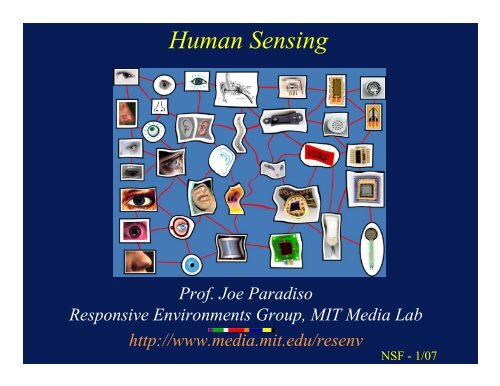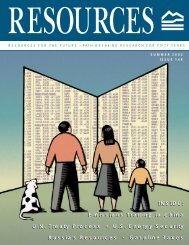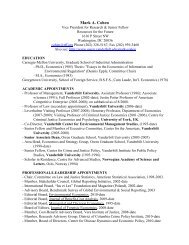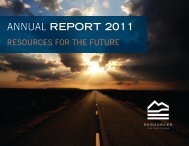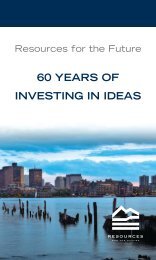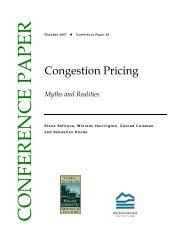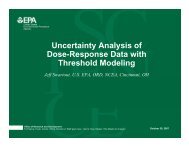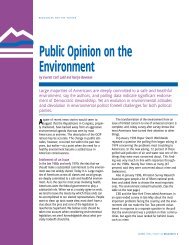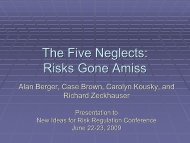Human Sensing
Human Sensing
Human Sensing
Create successful ePaper yourself
Turn your PDF publications into a flip-book with our unique Google optimized e-Paper software.
<strong>Human</strong> <strong>Sensing</strong><br />
Prof. Joe Paradiso<br />
Responsive Environments Group, MIT Media Lab<br />
http://www.media.mit.edu/resenv<br />
NSF - 1/07
1/07<br />
Outline<br />
JAP<br />
• Motivation<br />
• Wearable Wireless <strong>Sensing</strong><br />
– Interactive Media/HCI<br />
– Medical<br />
–Social<br />
• Infrastructure <strong>Human</strong> <strong>Sensing</strong><br />
2
1/07<br />
<strong>Sensing</strong> as Commodity<br />
JAP<br />
• Sensors are now becoming a commodity, and soon can<br />
easily be designed into most any device.<br />
– Rather than omitting them from a cost/complexity viewpoint, it<br />
begins to make more sense to just include them if there’s any<br />
suspicion that they could be needed.<br />
– This causes a shift in how sensors are used – rather than rely on<br />
only 1 or 2 sensors made a priori to measure particular quantities,<br />
many sensors will be used that don’t necessarily exactly measure<br />
the quantity of interest (especially as applications will become<br />
more general and evolve over time).<br />
3
1/07<br />
JAP<br />
Spring 07<br />
In Aachen<br />
200<br />
Attendees -<br />
Bartos filled<br />
4
1/07<br />
The Prototype Sensor Shoe: 1997<br />
JAP<br />
5
Expressive Footwear<br />
17 Data Channels<br />
• 2-axis tilt sensor<br />
• 3-axis compass<br />
• 1-axis rate gyro<br />
• 3-axis shock sensor<br />
• Height sensor (EFS)<br />
• Sonar receiver<br />
• 1 PVDF strip (sole)<br />
• 3 FSR pressure tabs (sole)<br />
• Bend sensor (sole)<br />
• 3 Volt Battery Reference<br />
• Battery low detect<br />
• 20 kb/sec wireless<br />
• 413 & 433 MHZ<br />
• PIC 16C711<br />
• 50 Hz updates from each foot.<br />
• ~ 50 mA draw<br />
- Half day or more of life
1/07<br />
Modular Wireless Sensor Stack - 2001<br />
JAP<br />
Compact Configurable<br />
Wireless Sensor Node<br />
7
New Modules for Sensor Stack<br />
Ari Benbasat<br />
• Environmental Board<br />
– VGA camera, PIR, IR,<br />
Visible light, microphone<br />
• Active/Passive IMU<br />
– 3 gyros, 3 accelerometers,<br />
3 passive tilt switches<br />
• Data Logger<br />
– 1 Gb of memory
The Wearable Gait Laboratory<br />
Stacy Morris
1/07<br />
“Shuffle Index” vs. “Stride Excitement” via CART<br />
JAP<br />
Minimum Foot Inclination (deg)<br />
Minimum pitch [degrees]<br />
-15<br />
-20<br />
-25<br />
-30<br />
-35<br />
NL F Y<br />
NL F<br />
PD F<br />
-40<br />
0.012 0.014 0.016 0.018 0.02 0.022 0.024 0.026 0.028 0.03<br />
Variation in Insole Force [normalized by bodyweight]<br />
10
Scaling to several dancers…<br />
Capacitive proximity to 50 cm<br />
6-axis IMU - 1 Mbps TDMA radio<br />
100 Hz Full State Updates from 25 nodes<br />
High Speed Sensor Fusion<br />
Vocabulary of features
Mid-March Diversion to Ft. Meyers, FL
Red Sox Spring Training - March 2006<br />
Biomotion measurement of a Red Sox Pitcher<br />
Modified sensors for high range and high sample rates<br />
• 1kHz sampling with data logged to flash memory<br />
• Torso - Single IMU with 10g accelerometer, 1500 deg/sec gyro<br />
• Upper Arm - Double IMU<br />
• 10g accel, 1500 deg/sec gyro<br />
• 70g accel (ADXL78), 10000 deg/sec gyro<br />
• Wrist - Double IMU<br />
• 10g accel, 1500 deg/sec gyro<br />
• 120g accel (ADXL193), 10000 deg/sec gyro<br />
• Hand - Single IMU with 120g accelerometer, 10000 deg/sec gyro
Preliminary Results - Red Sox Spring Training<br />
• Acceleration at the wrist<br />
peaks well above 100g<br />
• Most of this acceleration<br />
occurs in a 30ms window<br />
• Equates to 30 samples for<br />
the modified inertial system,<br />
but only 5 frames on a<br />
180Hz video capture system<br />
QuickTime and a<br />
YUV420 codec decompressor<br />
are needed to see this picture.<br />
Acceleration Phase of the Pitch Above Captured at Three Critical Locations - Hand, Wrist, and Biceps<br />
>100 g’s!!
The Disposable Wireless Sensors<br />
• Very simple “featherweight” motion sensor<br />
– Cantilevered PVDF piezo strip with proof mass<br />
– Activates CMOS dual monostable when jerked<br />
– Sends brief (50 µs) pulse of 300 MHz RF<br />
– 100 ms dead timer prevents multipulsing<br />
– Can zone to within ~10 meters via amplitude<br />
– Ultra low power – battery lasts up to shelf life<br />
– Extremely cheap – e.g., under $1.00 in large quantity
16<br />
Life Microscope: Wristband Node<br />
Kazuo Yano et al - Hitachi Research, Tokyo<br />
Size 6×4×1.5cm<br />
Weight 50g include battery<br />
Battery 1 Day internal battery<br />
4 Days external battery<br />
(※<strong>Sensing</strong> every 2 minutes)<br />
Wireless IEEE802.15.4 Range 30m<br />
Sensor Pulse, Acceleration,<br />
Temperature<br />
(C) Hitachi Ltd. 2006
17<br />
Life Microscope: Data<br />
Activity (/min) Pulse (/min)<br />
Pulse & Activity Monitoring Result<br />
140<br />
100<br />
50<br />
0<br />
400<br />
200<br />
0<br />
0 3 6 9 12 15 18 21<br />
Time [Hour]<br />
24<br />
(C) Hitachi Ltd. 2006
18<br />
Day (month/day)<br />
3/20<br />
3/21<br />
3/22<br />
3/23<br />
3/24<br />
3/25<br />
3/26<br />
3/27<br />
3/28<br />
Age 46, Male<br />
3/29<br />
3/30<br />
Activity Map<br />
4/1<br />
(accelerometer)<br />
4/2<br />
4/3<br />
4/4<br />
4/5<br />
4/6<br />
4/7<br />
4/8<br />
4/9<br />
4/10<br />
0 3 6 9 12 15 18 21<br />
Time [Hour]<br />
24<br />
(C) Hitachi Ltd. 2006
19<br />
Understand Real <strong>Human</strong> Behaviors<br />
“Satellite Image of My Life”<br />
<strong>Human</strong>-behavior knowledge & new services<br />
Vacation Season<br />
Travel Abroad<br />
(C) Hitachi Ltd. 2006
1/07<br />
Predicting User Comfort for Utility Control<br />
JAP<br />
Mark Feldmeier<br />
Humidity<br />
Temp.<br />
Comfort<br />
• User wore temperature and humidity sensors at 5 locations for 4<br />
days (December 2007)<br />
– Finger (rings), wrist (watches), neck (necklaces), chest (necklaces), shirt<br />
exterior (pendants)<br />
• Pager motor vibrated every 5 minutes to prompt user to key in<br />
HOT/COLD/NEUTRAL<br />
• 85% accurate in predicting comfort with all sensors<br />
– 83% accurate just w. wrist temperature, chest temperature, chest humidity<br />
20
The UberBadge<br />
Mediate Group Interaction & Behavior Modeling<br />
QuickTime and a<br />
TIFF (LZW) decompressor<br />
are needed to see this picture.<br />
Mat Laibowitz<br />
Responsive Environments<br />
Group<br />
• 16-bit MCU w/ 64kb flash, 2k<br />
RAM, and GCC support<br />
• 45-LED Display intended to be read<br />
at distance<br />
• IR communications<br />
• RF communications with second<br />
processor to handle MAC<br />
• Up to 256MB of data memory<br />
• Audio input and output with<br />
onboard microphone<br />
• Onboard accelerometer<br />
• Pager motor for vibratory feedback<br />
• Multiple ports for expansion<br />
– Accepts Sensor Stack Modules<br />
• Optional LCD display
1/07<br />
120 Badges Fabricated<br />
JAP<br />
• 100 UbER-Badges dispensed at the Media Lab’s Things<br />
That Think (TTT) Consortium Meeting on May 3, 2005<br />
• Facilitate interaction between research sponsor attendees<br />
and Media Lab<br />
• Take data for analyzing human dynamics<br />
• Day broken up into talks, coffee/lunch breaks, 3-hr Open<br />
House<br />
22
1/07<br />
Broadcast Messages<br />
Information on your badge is mainly for other people, not you!<br />
JAP<br />
23
1/07<br />
Audience Voting in Auditorium<br />
JAP<br />
QuickTime and a<br />
TIFF (LZW) decompressor<br />
are needed to see this picture.<br />
Yes<br />
63%<br />
No<br />
37%<br />
• Red = No, Green = Yes<br />
24
1/07<br />
Exchange Business Card, Bookmark Demos<br />
JAP<br />
QuickTime and a<br />
TIFF (LZW) decompressor<br />
are needed to see this picture.<br />
25
1/07<br />
Bookmark data posted on website<br />
JAP<br />
26
1/07<br />
Bookmark data posted on website<br />
JAP<br />
27
1/07<br />
Badge Accelerometer & Audio Data<br />
JAP<br />
28
1/07<br />
Auditorium Fidgeting<br />
JAP<br />
QuickTime and a<br />
TIFF (LZW) decompressor<br />
are needed to see this picture.<br />
• Medium-good correlation with length of talk<br />
• “Resets” with every presentation<br />
29
1/07<br />
Interest Meter & Group Dynamics<br />
JAP<br />
Badge-Badge<br />
80%<br />
Accuracy<br />
Badge-Demo<br />
Interested<br />
Interested<br />
Uninterested<br />
Uninterested<br />
Classification Value = f (voice, motion, face-face time…)<br />
Collaboration with <strong>Human</strong> Dynamics Group<br />
30
1/07<br />
Affiliated Wearers<br />
JAP<br />
Correlated Motion (accels)<br />
Face-Face Time (IR)<br />
Affiliated people tend to spend more time face-face<br />
and move together!<br />
Accuracy of inferred affiliation: 93%<br />
31
1/07<br />
Affiliated Wearers from Energy Only<br />
JAP<br />
QuickTime and a<br />
TIFF (LZW) decompressor<br />
are needed to see this picture.<br />
32
1/07<br />
Timekeeping for Talks<br />
JAP<br />
T – 3 mins T – 2 mins T – 1.5 mins T – 1 mins T – 30 sec<br />
Out of time!!<br />
• 24 talks in the morning (research updates)<br />
• 5 Minute time limit on each!<br />
• Audience badges flashed time queues<br />
• We didn’t run over (first time ever…)!!<br />
34
Block Diagram & Working<br />
Prototype<br />
QuickTime and a<br />
TIFF (LZW) decompressor<br />
are needed to see this picture.
The SocioScope Platform(s)<br />
• Location: GPS, tower ID<br />
• Proximity: Bluetooth, , IR<br />
• Movement and body language:<br />
accelerometers<br />
• Social Signals: voice, movement<br />
features<br />
Sandy Pentland, <strong>Human</strong> Dynamics Group
State Model of <strong>Human</strong> Behavior<br />
ps s −<br />
1 1<br />
scale<br />
cluster<br />
cluster<br />
( | )<br />
2 2<br />
t t 1<br />
p s<br />
p( st<br />
| st<br />
− 1)<br />
0 0<br />
p st<br />
st<br />
− 1<br />
( | )<br />
2 1<br />
(<br />
t<br />
| st)<br />
p s<br />
1 0<br />
(<br />
t<br />
| st)<br />
p x s<br />
0<br />
(<br />
t| t)<br />
Time CellTower IDs Time CellTower IDs Time CellTower IDs Time CellTower IDs<br />
time<br />
• Lots of different observations on different scales<br />
• Eigenvector analysis provides good prediction!
Friends:<br />
Self-Report vs. Automatic<br />
Self-Report Friendship<br />
1-Day Proximity
330,000 hours for 94 people<br />
Accuracy of social structure identification:<br />
• 95% for close circle of friends<br />
• 96% for work group<br />
• 98% for boss<br />
Predict work group satisfaction: r=0.57
1/07<br />
Personal multimodal Dosimeter<br />
JAP<br />
• Measure items of health/environment<br />
interest on wearable platform<br />
– Gas, chemicals, particulates, radiation, EM<br />
field, acoustic environment, UV, temperature,<br />
location…<br />
– Grass roots motivation (people vs<br />
establishment)<br />
– Mainly media artists now, but evolving<br />
• Simple products beginning<br />
• Tad Hirsh, MIT ML<br />
40
1/07<br />
MIT PlaceLab<br />
JAP<br />
QuickTime and a<br />
TIFF (LZW) decompressor<br />
are needed to see this picture.<br />
41
1/07<br />
Bootstrapping a Ubiquitous Sensor Infrastructure<br />
JAP<br />
• Sensor networks are the foot soldiers at the front<br />
lines of ubiquitous computing<br />
• At this point, few if any customers will buy an<br />
ensemble of “UbiComp” sensors<br />
• They will aggregate from established devices<br />
– Home security, appliances, utility devices, entertainment…<br />
Just as the web sprouted from a networked ensemble of<br />
personal computers, true “ubicomp” will arise from an<br />
armada of networked devices installed for other purposes.<br />
42
1/07<br />
Power Strips are Everywhere<br />
JAP<br />
• Needed in Homes, offices, especially the Media Lab!<br />
• Sensors are becoming commodity items<br />
– Cost of adding sensors to a design is becoming incremental<br />
• Power strips are ideal base platforms for hosting a<br />
sensor network<br />
– Ready access to power<br />
– Power line can be a network port<br />
– Can monitor the status of devices that are plugged in<br />
43
1/07<br />
PlugPoint – Power Strips as the backbone of a UbiComp Sensor Infrastructure<br />
J. Lifton, M. Feldmeier, Y. Ono (Ricoh)<br />
JAP<br />
Power Line provides<br />
energy & comm<br />
Monitor current profiles,<br />
Switch individual sockets<br />
Hosts basic sensors (mic,<br />
light, motion)<br />
Expansion Port for others<br />
Hub for wireless sensor<br />
network<br />
44
Army of Plugs<br />
QuickTime and a<br />
TIFF (Uncompressed) decompressor<br />
are needed to see this picture.<br />
30 ON MEDIA LAB THIRD FLOOR
SecondLab - Binding real sensor data to virtual worlds<br />
Third floor of ML built in<br />
Second Life<br />
ResEnv Lab rendered in<br />
detail - other areas currently<br />
derived from map<br />
QuickTime and a<br />
TIFF (Uncompressed) decompressor<br />
are needed to see this picture.<br />
Sensor data piped in and<br />
interpreted as real-time<br />
graphic phenomena<br />
Simple sensor apparitions to explore basic ideas<br />
- Energy use height of fire<br />
- Activity (sound, motion) whirlwinds<br />
- Active regions higher walls<br />
- “Ghost” face individual presence<br />
Josh Lifton - Building a virtual Media Lab in SecondLife
1/07<br />
Mobile User Interfaces for Sensor Networks<br />
JAP<br />
Browsing, querying,<br />
navigating through<br />
sensor net data<br />
What are the interface<br />
affordances, displays,<br />
interaction<br />
modalities?<br />
Privacy & Security?<br />
Mobile platform<br />
inside of network vs<br />
fixed platform<br />
outside?<br />
McLuhan Extension<br />
of human senses<br />
47
1/07<br />
Nokia 770 Sensor Net Tricorder - Mk. I<br />
JAP<br />
48
1/07<br />
Conclusions<br />
JAP<br />
• <strong>Sensing</strong>, computation, and communication become tightly integrated and<br />
commonly embedded<br />
• Low power and energy scavenging enable active nodes to be embedded and<br />
“forgotten”<br />
• The Ubicomp infrastructure permiates our cities, our dwellings, our objects, our<br />
clothing, and eventually our bodies<br />
– Pervasive-Wearable-Implantable<br />
• The 5 human senses locked into our body are augmented by interfaces into<br />
ubiquitous sensor network data<br />
– Marshall McLuhan for real<br />
– Interface devices now - implantables some day<br />
– Omniscience…<br />
• This infrastructure mediates everything<br />
– Collaboration, business, social interaction…<br />
– Context engines filter, represent, and manifest information<br />
• Google for reality<br />
• Brave New World<br />
– Privacy, security, promises vs. perils…<br />
49


